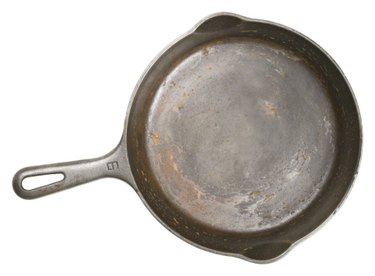Things You'll Need
Dish soap
Scrub brush
Steel wool
Vegetable oil, melted lard, melted bacon fat or melted shortening
Paper towels
Clean, dry towels

Cast iron cookware provides a variety of benefits to its owners. Although it is very heavy and requires special care, cast iron is durable, long-lasting and relatively inexpensive when compared with stainless steel and copper. Cast iron is also an excellent heat conductor and cooks very evenly. As noted by Mark Bittman in his New York Times article, you can move cast iron cookware from the stovetop to the oven for added cooking convenience. If your cast iron has developed rusty spots, you will need to reseason the cookware before using it again.
Step 1
Preheat the oven to 350 degrees Fahrenheit.
Video of the Day
Step 2
Wash the cookware in hot, soapy water with a scrub brush. This will begin to remove any seasoning that is left on your cookware, since most cast iron products come pre-seasoned.
Step 3
Scrub the cast iron with steel wool to remove the rest of the seasoning.
Step 4
Dry the cookware thoroughly with a clean, dry towel.
Step 5
Apply a thin layer of vegetable oil, melted lard, melted bacon fat or melted shortening to the entire surface of the cookware, using paper towels.
Step 6
Place the cookware in the oven, upside down on the top or middle rack.
Step 7
Bake for one hour, then turn the oven off and leave the cookware inside to cool.
Step 8
Remove cookware from the oven and place in a dry place for storage.
Tip
Prevent future rusting by always hand drying your cast iron products.
Boil a bit of water in the cookware before cleaning if there are food particles stuck to the bottom.
Video of the Day